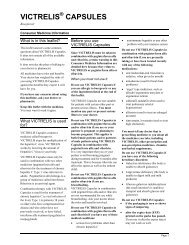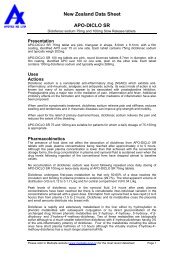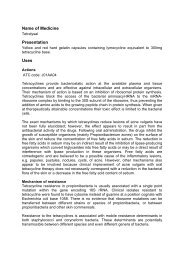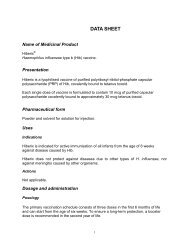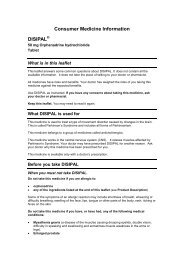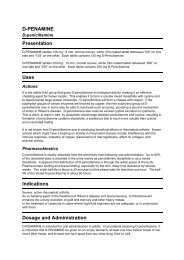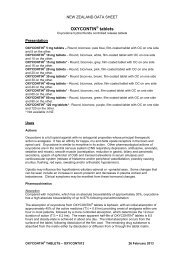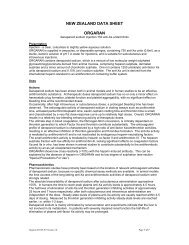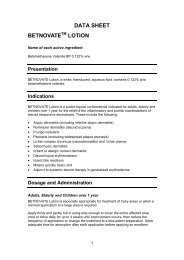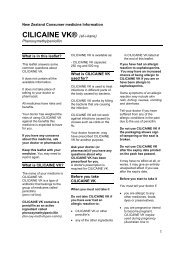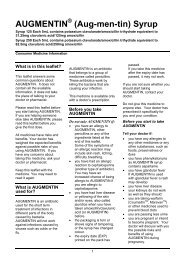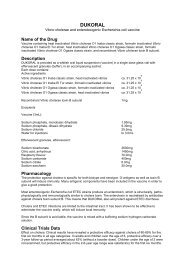Paracetamol + Codeine - Medsafe
Paracetamol + Codeine - Medsafe
Paracetamol + Codeine - Medsafe
Create successful ePaper yourself
Turn your PDF publications into a flip-book with our unique Google optimized e-Paper software.
• decreased respiratory reserve e.g. asthma or chronic obstructive pulmonary disease (COPD)<br />
• pre-existing respiratory depression<br />
• raised intracranial pressure or head injury<br />
• prostatic hypertrophy<br />
• hypotension<br />
• hypothyroidism<br />
It should also be used with caution in patients who:<br />
• have a history of drug abuse<br />
• are taking other respiratory depressants or sedatives, including alcohol<br />
• have had recent gastrointestinal tract surgery<br />
<strong>Codeine</strong> may obscure the diagnosis or the course of gastrointestinal diseases. Prolonged use of codeine<br />
may produce physical and psychological dependence.<br />
Ability to Drive and Operate Machinery<br />
<strong>Codeine</strong> may cause drowsiness. Those affected should not drive or operate machinery. See Interactions<br />
section for additional information.<br />
Use in Pregnancy<br />
Category A<br />
Both paracetamol and codeine have been taken by a large number of pregnant women and women of<br />
childbearing age without any proven increase in the frequency of malformations or other direct or indirect<br />
harmful effects on the foetus having been observed.<br />
Opioid analgesics may cause respiratory depression in the newborn infant. Prolonged high-dose use of<br />
codeine prior to delivery may produce codeine withdrawal symptoms in the neonate.<br />
Lactation<br />
<strong>Paracetamol</strong> is excreted in breast milk but neither paracetamol nor its metabolites were detected in the urine<br />
of nursing infants after 650 mg maternal dose. <strong>Codeine</strong> does pass into breast milk so should be avoided in<br />
breastfeeding women. When <strong>Paracetamol</strong> + <strong>Codeine</strong> is administered to a nursing mother, alternative<br />
arrangements should be made for feeding the infant.<br />
Analgesic doses excreted in breast milk are generally low. However, infants of breast feeding mothers taking<br />
codeine may have an increased risk of morphine overdose if the mother is an ultra rapid metaboliser of<br />
codeine.<br />
Breast feeding patients should be told how to recognise signs of high morphine levels in themselves and<br />
their babies. For example, in a mother, symptoms include extreme sleepiness and trouble caring for the<br />
baby. In the baby, symptoms include signs of increased sleepiness (more than usual), difficulty<br />
breastfeeding, breathing difficulties, or limpness. Medical advice should be sought immediately.<br />
Use in the Elderly<br />
The elderly are more likely to have age-related renal impairment and may be more susceptible to the<br />
respiratory effects of opioid analgesics. Dose reduction may be required.<br />
Interactions<br />
Salicylates and NSAIDs:<br />
Prolonged concurrent use of paracetamol and salicylates or non-steroidal anti-inflammatory drugs may<br />
increase the risk of adverse renal effects.<br />
Coumarins:<br />
Repeated high doses of paracetamol increase the risk of bleeding in patients taking warfarin and other<br />
coumarin derivatives. Monitoring of coagulation and bleeding complications is required.<br />
Page 3 of 6



